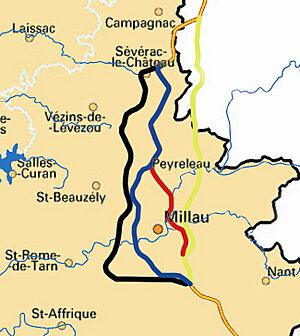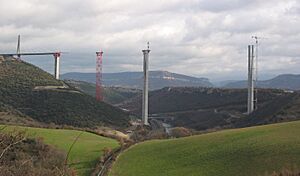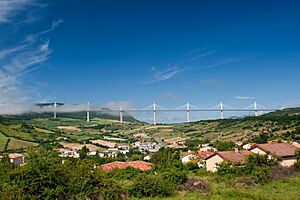Millau Viaduct facts for kids
Quick facts for kids Millau ViaductViaduc de Millau (French) |
|
|---|---|
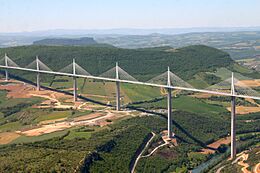
A view of the Millau Viaduct in 2005
|
|
| Coordinates | 44°04′46″N 03°01′20″E / 44.07944°N 3.02222°E |
| Carries | 4 lanes of the A75 autoroute |
| Crosses | Gorge valley of the river Tarn |
| Locale | Millau-Creissels, Aveyron, France |
| Official name | Viaduc de Millau |
| Maintained by | Compagnie Eiffage du Viaduc de Millau |
| Characteristics | |
| Design | Multiple-span cable-stayed viaduct motorway bridge |
| Material | Concrete, steel |
| Total length | 2,460 m (8,070 ft) |
| Width | 32.05 m (105.2 ft) |
| Height | 343 m (1,125 ft) (max pylon above ground) |
| Longest span | 342 m (1,122 ft) |
| Number of spans | 204 m (669 ft), 6×342 m (1,122 ft), 204 m (669 ft) |
| Clearance below | 270 m (890 ft) |
| Design life | 120 years |
| History | |
| Designer | Dr Michel Virlogeux, structural engineer |
| Constructed by | Compagnie Eiffage du Viaduc de Millau |
| Construction begin | 16 October 2001 |
| Construction cost | €394 million |
| Opened | 16 December 2004, at 9:00 |
| Inaugurated | 14 December 2004 |
| Statistics | |
| Toll | from €8.30 |
The Millau Viaduct (called Viaduc de Millau in French) is a huge cable-stayed bridge in Southern France. It was finished in 2004. This amazing bridge crosses the deep valley of the Tarn River near the town of Millau.
The bridge was designed by engineer Michel Virlogeux and architect Norman Foster. It is one of the tallest bridges in the world. Its highest point is 343 metres (1,125 ft) (about 1,125 feet) tall.
The Millau Viaduct is an important part of the A75 motorway. This road connects Paris to cities like Béziers and Montpellier. Building the bridge cost about €394 million. It took three years to build. The bridge officially opened on December 14, 2004. Traffic started using it two days later. Many people consider it one of the greatest engineering achievements of modern times.
Contents
Building the Millau Viaduct
Why the Bridge Was Needed
In the 1980s, the area around Millau had a big problem. Too many cars caused huge traffic jams, especially in summer. People traveling from Paris to Spain would get stuck. A new road was needed to help traffic flow better. It would also make it easier for people to get to Millau. Building a large bridge over the river valley was one idea.
Choosing the Best Design
Experts started planning a bridge in 1987. By 1991, they decided to build a long bridge, about 2,500 metres (8,200 ft) (1.5 miles) long. Many architects and engineers shared their ideas. In 1996, a special group chose a "cable-stayed" design. This design uses strong cables to hold up the bridge deck. Michel Virlogeux and Norman Foster led the team that created this winning design.
Several possible routes were looked at for the new road.
- The "Great Eastern" route was shorter but hard to build.
- The "Great Western" route was longer and would affect nature.
- The "Near RN9" route would help Millau but had technical issues.
- The "Intermediate" route, west of Millau, was chosen. It had some challenges but was the best fit.
After more studies, they decided on a "high solution." This meant building a very tall viaduct.
Who Built It?
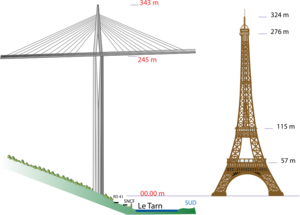
In 1999, companies from all over the world offered to build the bridge. The company Eiffage won the contract. They created a special company called Compagnie Eiffage du Viaduc de Millau (CEVM). Many parts of the Eiffage group worked on the project. For example, the Eiffel company built the steel roadway.
The bridge cost about €394 million to build. Eiffage paid for the construction. In return, they get to collect tolls (fees) from drivers for 75 years. The bridge is expected to last for at least 120 years.
Some People Were Against It
Not everyone thought the bridge was a good idea. Some groups worried about the environment. They also thought the bridge would be too expensive. They believed people wouldn't use it because of the toll. Some even worried the bridge wouldn't be safe. However, experts studied these concerns carefully.
How the Bridge Was Built
Building the Piers
Work on the bridge started in October 2001. First, workers dug deep holes for the foundations of the piers (the tall supports). Each pier stands on four concrete pilings. These pilings are 15 metres (49 ft) (about 49 feet) deep and 5 metres (16 ft) (about 16 feet) wide. They make sure the piers are very stable.
By March 2002, the piers began to rise from the ground. They grew very quickly, about 4 metres (13 ft) (13 feet) every three days! This was possible because of a special method called "sliding shuttering." It allowed new layers of concrete to be poured often.
Launching the Road Deck
The long road deck of the bridge was built in two halves. Workers assembled these halves on flat areas at each end of the viaduct. Then, they slowly pushed the huge steel deck across the piers. This was done using a special "bridge launching" technique.
During this process, eight temporary towers also helped support the deck. These towers were removed once the main structure was complete. Powerful hydraulic jacks pushed the deck forward. Each pylon also had a special mechanism on top to help move the deck. This system moved the deck about 600 millimetres (24 in) (2 feet) every four minutes.
Adding the Masts and Cables
After the road deck was in place, the tall masts were added. These masts were brought in pieces, assembled horizontally on the deck, and then carefully tilted upright. Once the masts were standing, the strong steel cables, called "stays," were attached. These cables connect the masts to the road deck, holding it up. After everything was tightened and tested, the temporary towers were taken down.
Key Dates in Construction
- October 16, 2001: Construction officially began.
- December 14, 2001: The first stone was laid.
- November 2003: The last and tallest piers were finished.
- May 28, 2004: The two halves of the road deck met in the middle.
- December 14, 2004: The bridge was officially opened.
- December 16, 2004: The bridge opened to traffic, ahead of schedule!
Amazing Records Set by the Bridge
The Millau Viaduct broke several world records:
- It was built without any serious accidents during the three years of construction.
- Its piers P2 and P3 are the tallest in the world, at 244.96 metres (803.7 ft) and 221.05 metres (725.2 ft) respectively.
- The mast on top of pylon P2 reaches 343 metres (1,125 ft), making it the highest bridge tower in the world.
- The road deck is 270 metres (890 ft) above the Tarn River, making it the highest road bridge deck in Europe.
Where is the Bridge?
The Millau Viaduct is located in France, near the towns of Millau and Creissels. Before the bridge, cars had to drive down into the Tarn valley. This caused big traffic jams during holidays. Now, the bridge crosses high above the valley. It connects two high plateaus, the Causse du Larzac and the Causse Rouge.
The bridge is the final part of the A75 motorway. This motorway provides a fast route from Paris to the south of France and even to Spain. It saves a lot of time and money for travelers. Most of the A75 is free, but you have to pay a toll to cross the Millau Viaduct.
The company that built the bridge, Eiffage, also manages it. They collect tolls to cover the building costs. As of 2018, the toll for a car was about €8.30, or €10.40 during busy summer months.
How the Bridge is Built (Structure)
Piers and Road Deck
The bridge has seven main piers. Each pier is supported by four deep concrete shafts. The piers vary in height, with P2 being the tallest at 244.96 metres (803.7 ft).
The road deck is made of metal and looks very light. It is 2,460 metres (8,070 ft) (about 1.5 miles) long and 32 metres (105 ft) (about 105 feet) wide. It has eight sections, called spans. The middle six spans are each 342 metres (1,122 ft) long. The deck is shaped like an airplane wing. This helps it stay stable in strong winds.
Masts and Cable Stays
Seven tall masts sit on top of the concrete piers. Each mast is 87 metres (285 ft) (about 285 feet) high. From each mast, eleven pairs of strong steel cables, called "cable stays," stretch down to support the road deck. These cables are made of many smaller steel wires. They have special protection to stop them from rusting.
Road Surface and Electronics
The road surface on the bridge is special. It's made of a flexible material called modified bitumen. This allows the road to bend slightly with the steel deck without cracking.
The bridge also has a lot of electronic equipment. There are 30 kilometres (19 mi) (18 miles) of electrical cables and 20 kilometres (12 mi) (12 miles) of fibre optic cables. Many sensors are built into the bridge. These sensors check for any movement and measure how the bridge handles wind and traffic. They can even tell how heavy vehicles are and how fast they are going. All this information helps engineers make sure the bridge stays safe.
Toll Plaza and Rest Area
The toll plaza is about 4 kilometres (2.5 mi) (2.5 miles) north of the bridge. It has sixteen lanes for cars to pay the toll. There's also a large, leaf-shaped roof over the toll booths. Near the toll plaza, there is a rest area called Brocuéjouls. It has a renovated old farm building and offers great views of the viaduct.
Bridge Facts and Figures
- Total length: 2,460 metres (8,070 ft) (1.5 miles)
- Number of piers: 7
- Height of tallest pier (P2): 244.96 metres (803.7 ft) (803 feet)
- Height of masts: 87 metres (285 ft) (285 feet)
- Number of cable stays: 154
- Average height of road deck: 270 metres (890 ft) (886 feet)
- Width of road deck: 32.05 metres (105.2 ft) (105 feet)
- Total concrete used: 85,000 cubic metres (3,000,000 cu ft) (111,100 cubic yards)
- Total weight of the bridge: 290,000 tonnes (290,000 long tons; 320,000 short tons) (319,670 short tons)
- Daily traffic: 10,000–25,000 vehicles
- Typical car toll (2018): €8.30 to €10.40
Fun Facts and Events
Running on the Bridge
Even though the bridge is usually closed to people walking, there have been special events.
- In December 2004, before the bridge opened to cars, 19,000 people walked or ran across it.
- On May 13, 2007, over 10,000 runners took part in a race that went across the viaduct and back. The total distance was 23.7 kilometres (14.7 mi) (14.7 miles).
Other Interesting Facts
- The speed limit on the bridge was lowered from 130 kilometres per hour (81 mph) to 110 kilometres per hour (68 mph). This was because tourists were slowing down to take pictures!
- A special postage stamp was made to celebrate the bridge's opening.
- The Millau Viaduct has appeared in movies and TV shows. It was in the 2007 film Mr. Bean's Holiday. It also appeared in the video game James Bond 007: Blood Stone. The British TV show Top Gear featured the bridge in one of their road trips.
Images for kids
See also
 In Spanish: Viaducto de Millau para niños
In Spanish: Viaducto de Millau para niños


